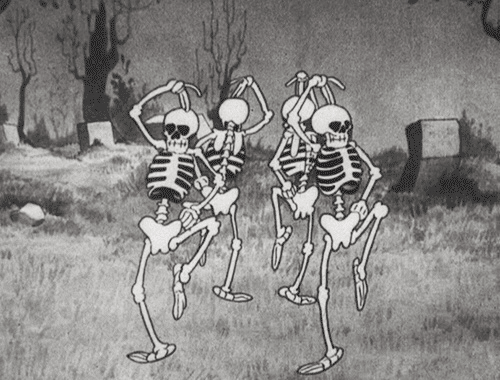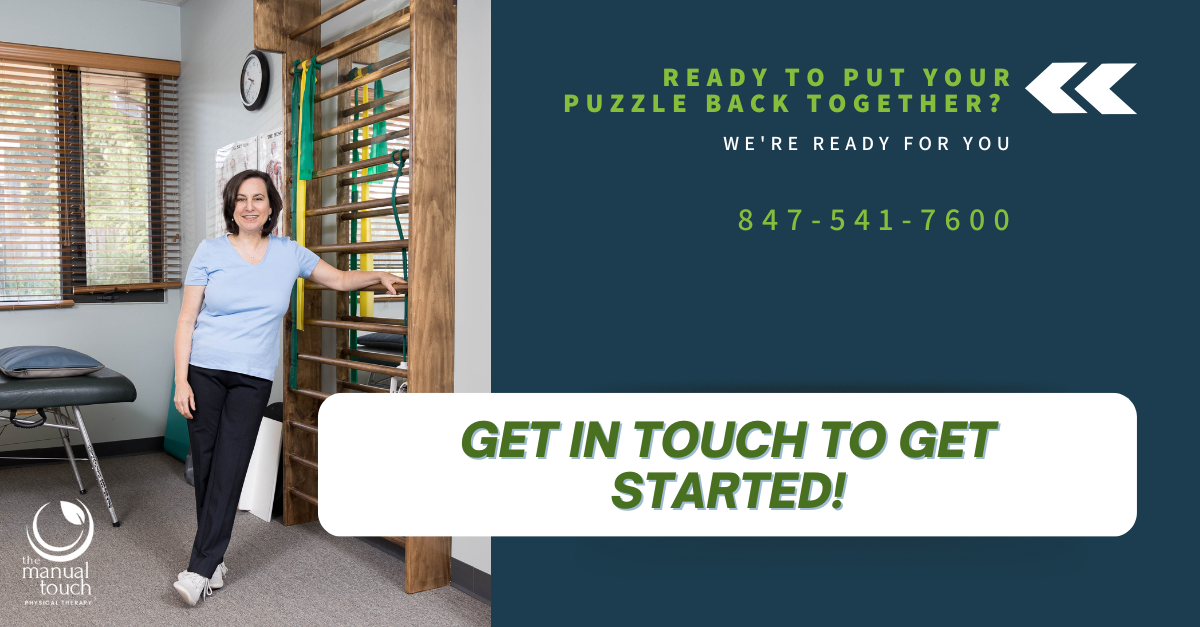Dem bones, dem bones, dem dry bones,
Dem bones, dem bones, dem dry bones,
Dem bones, dem bones, dem dry bones,
Now shake dem skeleton bones!
Like the children’s classic song “Dem bones” says, everything is connected. Here at The Manual Touch, we firmly believe that. When you come in to see us, it doesn’t matter what your primary complaint is. We want to hear your full medical history, where else you might be having symptoms, and any accidents you might have had in your entire lifetime. After we listen closely to your answers, we might begin formulating some ideas about what’s going on with you. We’ll look at your body like a puzzle and establish which pieces connect and which pieces aren’t connecting and why. However, your story, like first doing the border of a jigsaw puzzle, is just the first huge piece of your puzzle.
The toe bone’s connected to the foot bone,
The foot bone’s connected to the ankle bone,
The ankle bone’s connected to the leg bone,
Now shake dem skeleton bones!
We do a thorough physical therapy evaluation, we like to call the “whole body approach”, of your movement, strength, balance, gait, and palpation (hands-on checking for any points of tenderness or limitations). We will also do basic neurological testing such as reflexes and checking your ability to feel specific sensations – light touch, hot/cold, and vibration. These are more pieces of your puzzle, similar to different sections that make up the middle of a jigsaw puzzle
The leg bone’s connected to the knee bone,
The knee bone’s connected to the thigh bone,
The thigh bone’s connected to the hip bone,
Now shake dem skeleton bones!
“I’ve had scoliosis for 40 years and increasing pain for the last 25. I tore my hip labrum in 2012, and even after surgery in 2016, I never fully recovered. Then I had a spinal fusion from L4 to T10. I’ve seen many therapists, but Denise was different—she didn’t follow a protocol, she followed me. She listened, adapted, and helped me heal when nothing else had worked. She was my partner in recovery, and I could feel her joy when I progressed.” – Andrea, 2023
Examples of the “Whole Body Approach”:
Diane has SI (sacroiliac) joint (located in the buttock) pain. When walking, I noticed she landed hard on her right foot because she lacked normal right ankle pronation. This caused excessive stress on her right SI joint. After mobilizing her right ankle and SI joint, she can now walk with less stress on her SI joints and she has no pain.
Emma’s feet turn in when she walks because of weak feet and lack of ankle mobility, causing her low back to excessively rotate making up for the lack of rotation in her ankles. Emma does feet and core exercises on the OOV to improve the neuromuscular control of her legs and core. Now her gait is much better, including her feet being in better alignment.
Leia had jaw instability. She always needed to move her jaw around to find a stable point. I noticed she moved her jaw around more when standing rather than sitting. Upon further exam, her feet were very weak and she had poor neuromuscular control between her feet and core. Leia began doing exercises sitting on a large exercise ball, eliminating her feet from influencing her. She got good supportive shoes and orthotics. As she gained strength and better feet stability, her exercise program progressed to include exercises in standing in order to integrate her feet with the rest of her body. As Leia’s feet and neuromuscular control improved, she was able to stand with improved jaw stability and less need to adjust her jaw.
The hip bone’s connected to the backbone
The backbone’s connected to the neck bone,
The neck bone’s connected to the head bone,
Now shake dem skeleton bones!
The Pieces of Your Puzzle
Of course, unlike the Dem bones song, you are more than just bones. You have blood vessels, nerves, organs, and fascia, a weblike tissue that surrounds every structure in your body like the thin film of tissue surrounding chicken breast meat. That is fascia.
Have you ever pulled on a loose sweater yarn at the bottom of your sweater and felt it pulling up into your neck? That happens when there are restrictions in the fascia away from your body that have the symptoms. Understanding that all these different tissues connect via this web gives us more pieces of your puzzle.
The finger bone’s connected to the hand bone,
The hand bone’s connected to the arm bone,
The arm bone’s connected to the shoulder bone,
Now shake dem skeleton bones!
Several years ago, I did an aptitude test for an agency researching physical therapists. There were many tests similar to puzzles, like word and number sequencing or art and sound differentiation. One of the tests I, and all the other PTs, excelled in is a spatial aptitude test using a piece of paper folded multiple times and then a hole punched into the papers. We then had to determine where all the holes would be when the paper was unfolded.
Just like these tests help us learn where you may be “falling apart,” they also help us learn how to put you back together, like a puzzle. Puzzles have corner pieces, straight pieces and middle pieces. Some people start with the border, some start in the middle. Either way, they get where they are supposed to be. At The Manual Touch, we use a whole body approach of traditional and non-traditional therapies to get you back doing the things you love to do. We start with the border AND the middle pieces to find a holistic solution for your puzzle.
Upon completion of your evaluation, using our knowledge base, particularly our spatial aptitude ability and vast experience, along with your story and the objective findings from the evaluation, we will begin to put all those pieces of your puzzle together. We will then explain to you what we believe is causing your symptoms, create a plan to put your puzzle pieces back together, and return you to doing the things you love to do with less or no symptoms.
Dem bones, dem bones gonna walk around
Dem bones, dem bones, gonna walk around
Dem bones, dem bones, gonna walk around
Now shake dem skeleton bones!
So, don’t be surprised when you are in our clinic for neck pain and we tell you it’s because of somewhere else in your body – such as your feet!








Leave a Reply